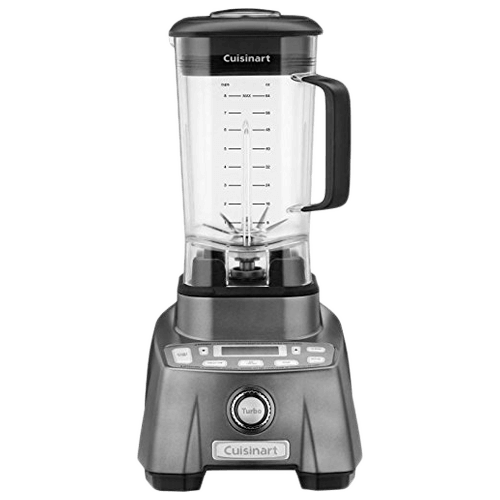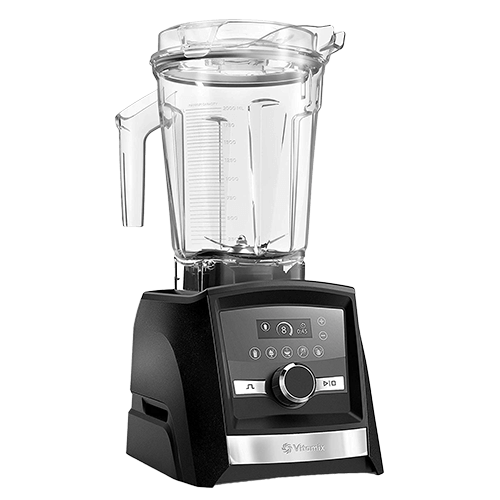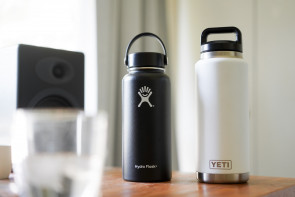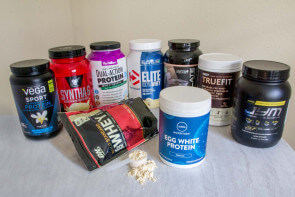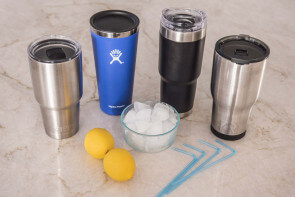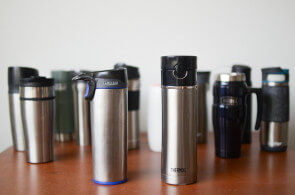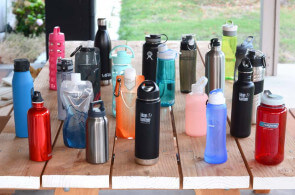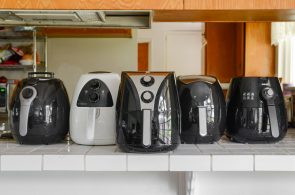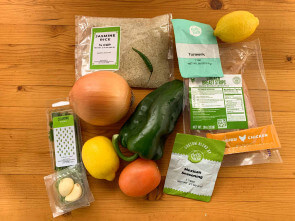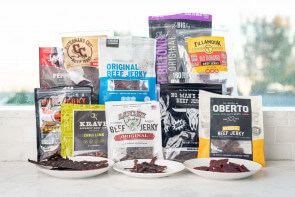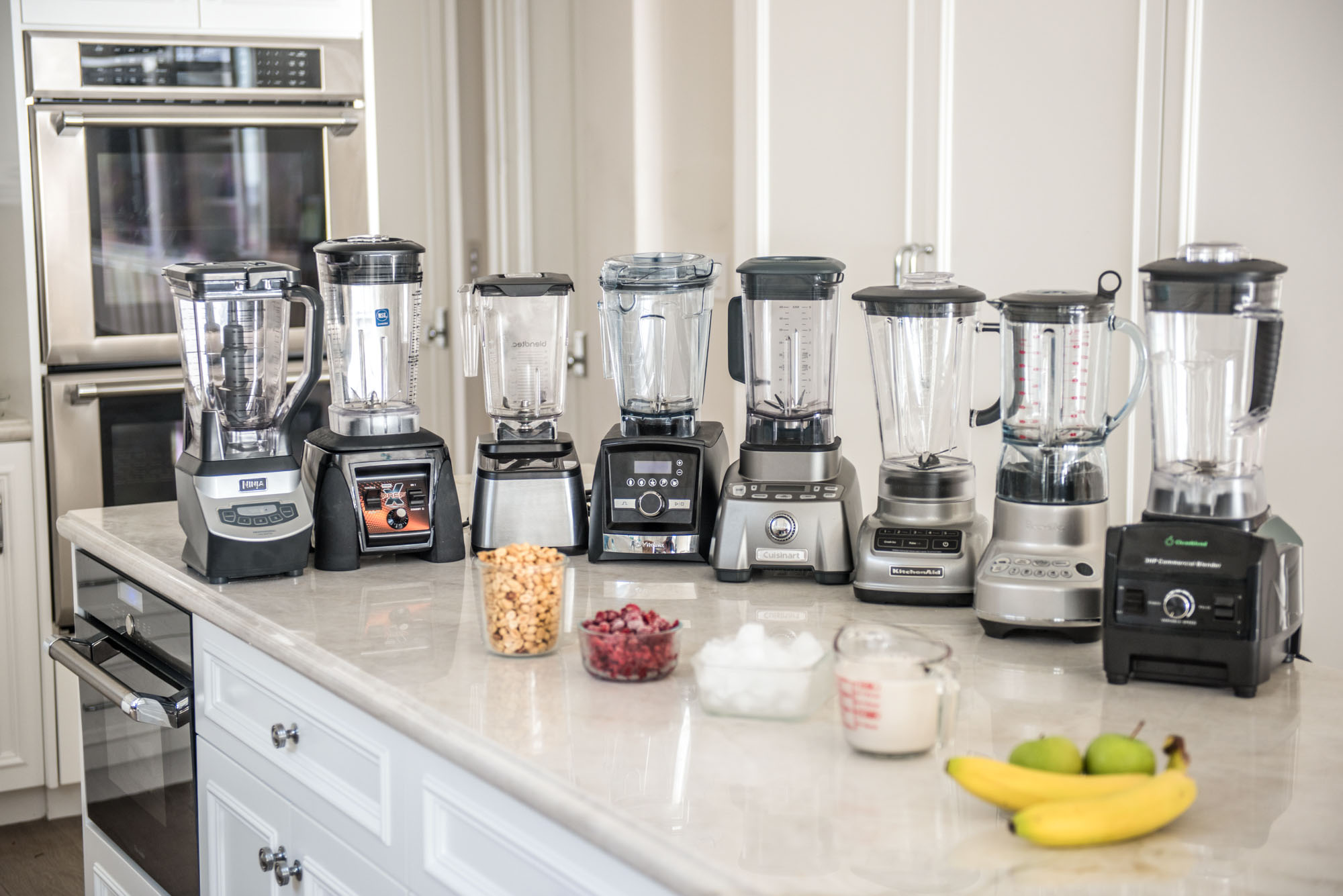
The 9 Best Blenders
Whether you’re making a fruit or green smoothie, you need a powerful blender that can pulverize gnarly seeds, tough leaves and stems into a silky-smooth drink. But with so many blenders on the market at different price points, it’s hard to figure out which one is right for you. Our professional chef spent 30-plus hours blending 30 pounds of produce to determine that the Cuisinart – CBT-2000 is the best all-around mid-range blender for making smoothies, soups and nut butter on a frequent basis.
If making smoothies or juices is part of your daily lifestyle — and you don’t mind spending substantially more money — then we recommend the high-performance Vitamix – A3500. Our low-priced pick, Cleanblend – 2001, doesn’t have programmed functions and it isn’t great for processing nut butters, but it matched the Cuisinart and Vitamix in overall blending.
Table of contents
- The 9 blenders we tested
- 1. Best high-end blender: Vitamix – A3500
- 2. Best mid-range blender: Cuisinart – CBT-2000
- 3. Best low-end blender: Cleanblend – 2001
- How we selected
- How we tested
- Important features to consider
- The bottom line
The 9 blenders we tested
| Product | Price | Wattage | Ease of Use | Performance |
|---|---|---|---|---|
| 1. Vitamix - A3500 | $$$$ | 1500 | 5/5 | 5/5 |
| 2. Cuisinart - CBT-2000 | $$$ | 1677 | 5/5 | 4/5 |
| 3. Cleanblend - 2001 | $$ | 1800 | 4/5 | 4/5 |
| 4. Vitamix – Ascent 2300 | ||||
| 5. Breville - BBL620AIL1AUS1 | $$$ | 1500 | 5/5 | 5/5 |
| 6. Waring - MX1200XTX | $$$ | 1500 | 3/5 | 4/5 |
| 7. Blendtec - D725C321A1A | $$$$ | 1570 | 4/5 | 3/5 |
| 8. Ninja - BL660 | $$ | 1100 | 3/5 | 2/5 |
| 9. KitchenAid - KSB1575CU | $$ | 550 | 2/5 | 2/5 |
1. Best high-end blender: Vitamix
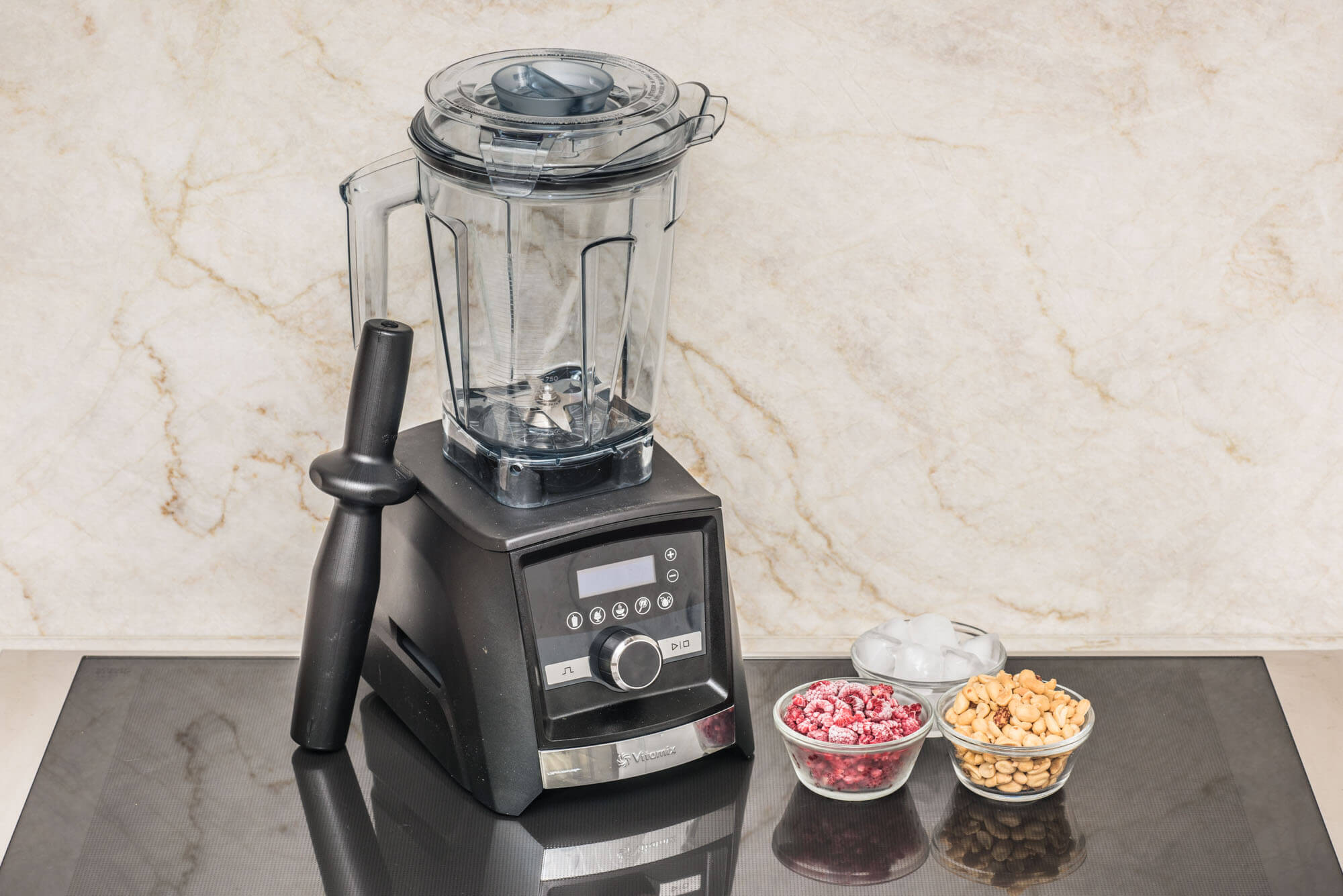
In the ongoing marketing battle between the most expensive blenders, Vitamix and Blendtec, Vitamix – A3500 wins hands down. The Vitamix’s powerful 1500-watt motor crushes ice cubes into powdery snow in seconds, purees and heats vegetables to hot soup in minutes, and pulverizes entire fruits — seeds, core, and fruit skins — and sturdy kale and other hearty greens into silky smoothies with no sediment.
Initially, we were a bit suspicious of Vitamix. There’s so much hype around it, and the product demonstrations at stores can be overbearing. Subsequently, we were a bit more stringent in testing Vitamix, but, except for one test, this powerhouse blender completely won us over.
So why is Vitamix so good? Let’s start with the smoothies since they will most likely be a major consideration if you’re thinking about buying one.
Vitamix has a pre-set function for smoothies timed at a mere 50 seconds. The cycle begins at the mid-speed, level 5, for ten seconds, during which it draws down the ice to the blades and pulverizes it to powder. The cycle then speeds up to its highest level and processes the ingredients in 40 seconds. We were hypnotized by the cyclonic blur of the Vitamix’s vortex as the smoothies were blended.
No other blender we tested could beat Vitamix’s ability to grind the raspberry seeds in the fruit smoothie. The ground seeds had texture but not graininess. We strained the smoothie, and no seed bits were left behind.
Vitamix doesn’t have a separate cycle for green smoothies, but no matter, it worked exactly the same, and our green smoothie was silky with no sediment. Because of Vitamix’s marketing videos depict whole fruits and vegetables being processed, we threw in whole kale leaves, an entire apple — without coring or seeding — and un-cut stalks of celery. Vitamix processed it all without a struggle, and gave us a smoothie that was like a super-refined juice.
As we noted above, the soup function is a wonder, if you enjoy hot soup on a cold day, you can have it freshly made and piping hot in under six minutes. The tomato-basil soup we made in the Vitamix exploded with fresh tomato and herbal flavor, and although it was composed entirely of vegetables, the Vitamix blended it into a frothy emulsion that tasted creamy.
Making peanut butter was a little less stress-free. As we noted earlier, the width of the blender jar for this particular model necessitated our using a minimum of four cups of nuts; otherwise, the finely ground peanuts got lodged beneath the blades. When we added more peanuts on our second attempt, the Vitamix achieved peanut butter in about two minutes.
The only test that the Vitamix failed was the Hollandaise. For the sauce to emulsify, the eggs needed to be beaten for 30 seconds. But the eggs could not be tightly contained in the Vitamix’s wide blender jar, so they just whizzed around underneath the blades. We tried increasing the speed, and the vortex lifted the eggs up but again failed to beat them. When we added the hot butter, it simply splattered and never came together as a thick sauce.
The Vitamix has a great auto-clean function that’s preset at 35 seconds. It goes through three cycles that effectively washes away everything along the sides and bottom of the pitcher all the way up to the lid.
If we had one negative about the Vitamix’s design, it’s that the lid attaches to the blender jar by two plastic tabs. They’re made of the same tough Tritan copolyester as the blender jar, but when we pressed down on the tabs, there wasn’t a click to indicate that we had actually fastened the lid securely on.
Of course, at $600, the Vitamix is certainly an investment. But if improving your diet is important, and blending smoothies or making fresh juices is part of your daily regimen, we believe it will be money well spent. Vitamix’s amazing and unique ten-year warranty is proof they’re confident this blender will last with everyday use.
Key takeaways:
- The Vitamix – A3500 powerful 1500-watt motor and expertly engineered blades crush ice, puree soup and completely pulverize seeded fruits and hearty vegetables into silky smoothies.
- Its pre-programmed functions for smoothies, soup, desserts, dips, and auto-clean are precisely timed to give perfect results.
- Vitamix’s ten-year warranty is the most extensive for any blender on the market today.
- Straight out of the box, it’s incredibly easy and convenient to use.
- The Vitamix is pricey, but it’s built to last, and if you make smoothies or juices as part of your daily regimen, you can be assured that it will last for years.
2. Best mid-range blender: Cuisinart
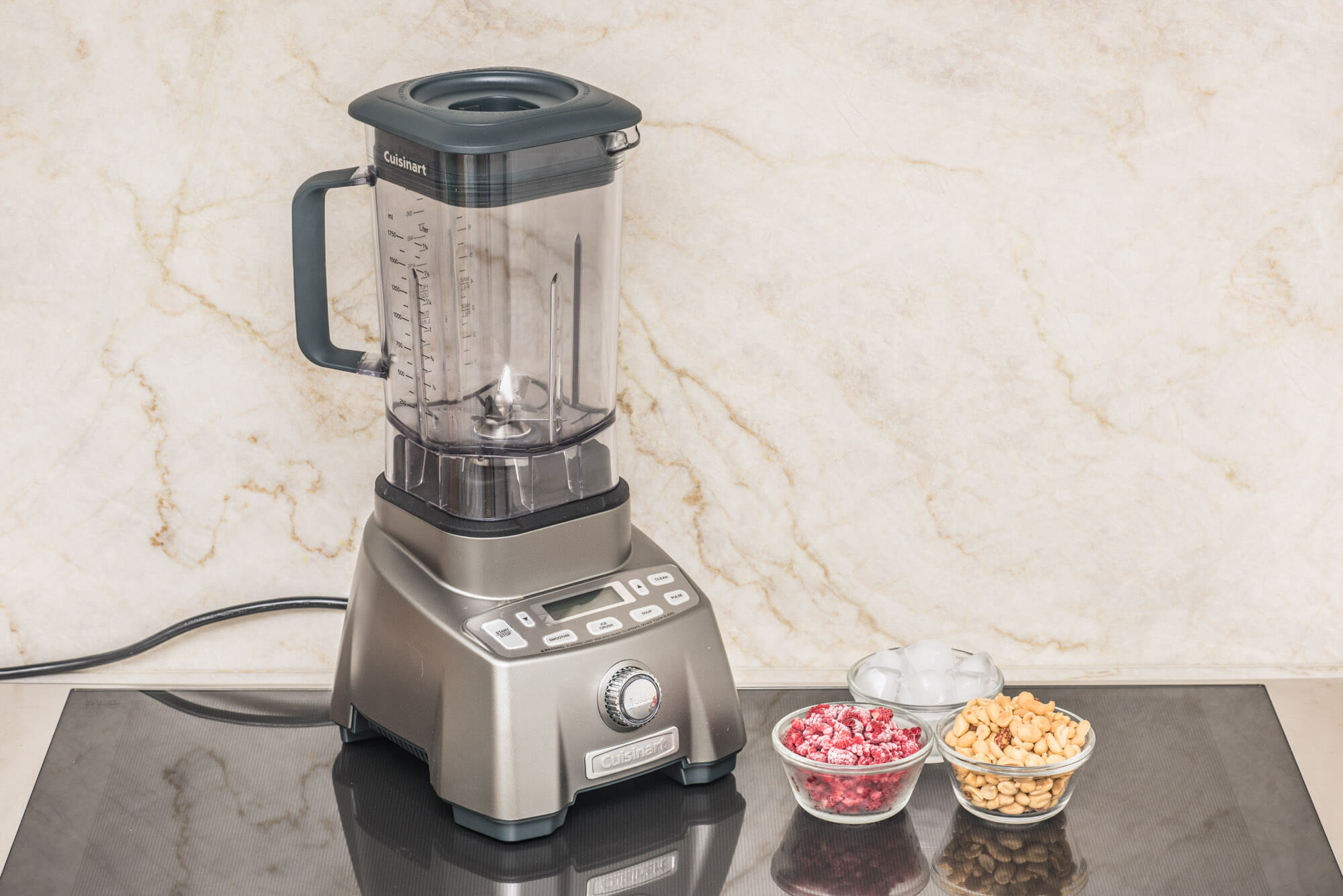
If you don’t want to spend a good chunk of your paycheck on a Vitamix, but you do want a blender for a daily smoothie, there are several mid-range blenders to consider. During our testing, we found that a couple of the mid-range blenders performed nearly as well as Vitamix, and the differences in texture and consistency of their smoothies and soups were minimal.
At 1,677 watts, the Cuisinart – CBT-2000 has plenty of power. It has five pre-programmed functions, an LCD screen with a countdown timer, and a variable speed dial that can be minutely adjusted from lowest to highest at any time during blending. The dial also has a push-button “turbo” function that instantly increases the speed to high in short bursts.
The Cuisinart’s function for fruit smoothies is preset at 45 seconds and runs through various speeds at ten-second intervals, finishing with a final burst at high. Its fruit smoothie was nearly as perfect as the Vitamix’s with just a touch of minuscule seed bits.
The Cuisinart has a separate function for green smoothies with a longer time (one minute, 30 seconds) and the different cycle of speeds. Again, the Cuisinart’s performance matched Vitamix, blending the tough kale and apple seeds and core to velvety smoothness.
The soup function blends and heats the soup in six minutes, and it may not have had the creamy emulsification of Vitamix’s soup, but it was still perfectly smooth and nearly boiling hot.
As noted earlier, it was a chore to make peanut butter in all of the blenders we tested. The Cuisinart’s lowest speed finely chopped the peanuts in seconds, but as we increased the speed to form butter, the peanut bits splattered up the sides of the blender jar and lodged underneath the blades. We had to continuously scrape together the ground peanuts for about five minutes before they coalesced into a relatively smooth peanut butter.
The Cuisinart did not perform as well in making Hollandaise. Its blender jar is similar to the Vitamix and has almost no tapering at the bottom. Consequently, the blades couldn’t contain the eggs in a tight vortex, so when the butter was added, everything sprayed up without ever emulsifying.
The Cuisinart’s preset clean function is 30 seconds at medium speed, which worked fine for washing off smoothie and soup residue. But we needed to run the program twice to clean off the sticky peanut butter that was lodged underneath the blades.
The Cuisinart – CBT-2000 comes with an attractive recipe book that includes recipes for smoothies, frozen cocktails, soups, salad dressings, and desserts. We were extremely impressed by the Cuisinart’s versatility, durability, and ease of use, and at under $300, it’s a great alternative to Vitamix.
We should note that the Breville – BBL910XL (“The Boss”) was one of our best contenders in the mid-range category. However, near the end of our test period, Breville abruptly discontinued this excellent blender, which is now only available on the Breville website.
Key takeaways:
- The Cuisinart – CBT-2000 can do virtually everything the Vitamix can, but it’s half the price.
- Its powerful and durable 1677-watt motor blended velvety smooth fruit and green smoothies with barely perceptible residue from seeds.
- The Cuisinart’s accurate, preset functions include hot soup, ice crush, auto-clean and two different programs for fruit and green smoothies.
- It’s easy and convenient to use, and its versatility makes the Cuisinart “Hurricane Pro” one of the best all-around blenders you could buy.
3. Best low-end blender: Cleanblend
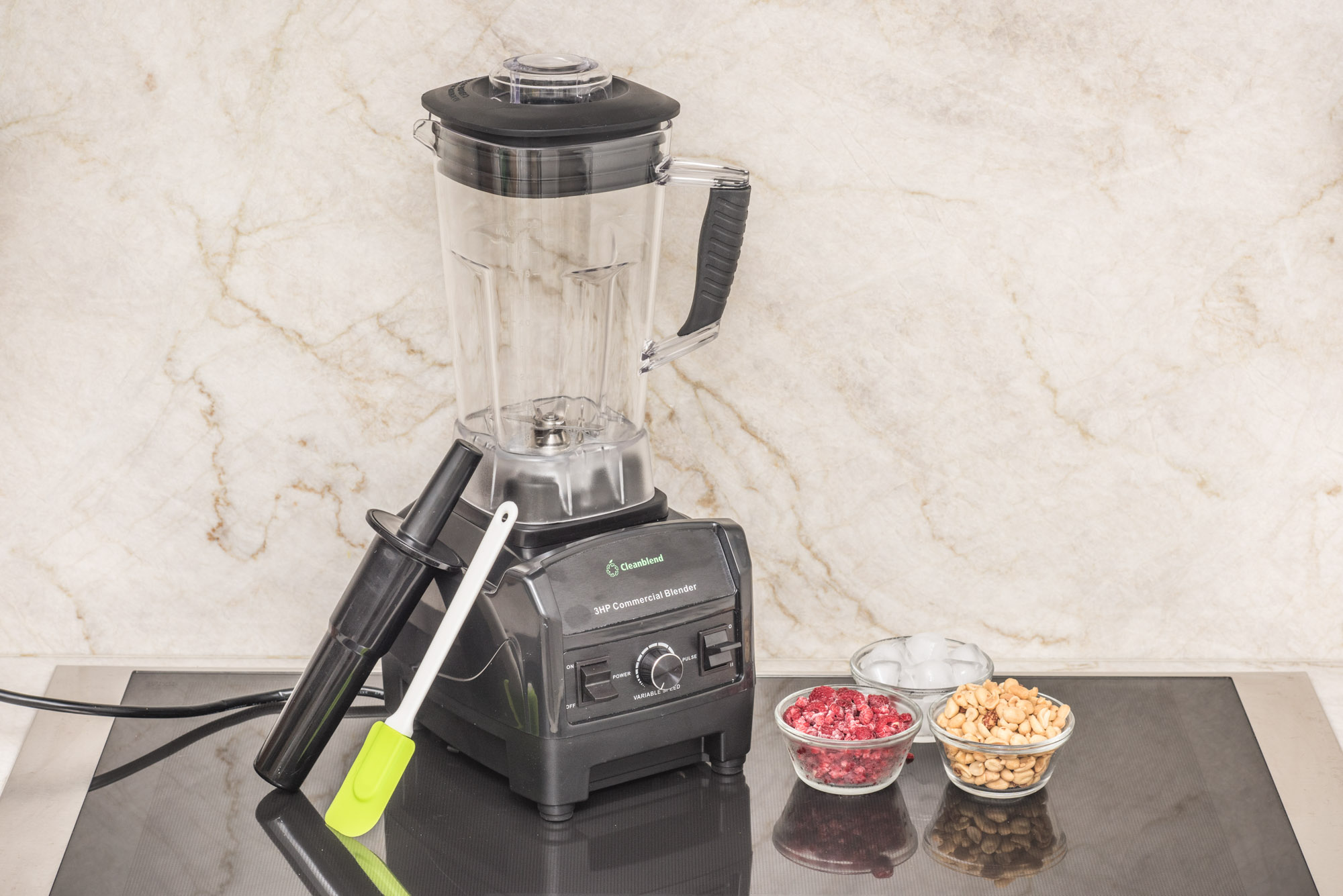
Fans of the Cleanblend – 2001 claim that it performs exactly the same as a Vitamix for a third of the price. Their claim didn’t entirely hold up, but the Cleanblend was far superior to the two other low-end blenders we tested. It has an extraordinarily powerful motor — 1800 watts — more powerful than the Vitamix, and excellent speed control.
Outwardly, compared to Vitamix, the Cleanblend looks simple. It’s very easy to operate and physically recalls a slightly squatter version of a 1970’s Waring blender. It has no pre-programmed functions and operates simply with an on/off switch. A center knob controls the speed levels and a second switch allows short controlled bursts.
The motor is quite heavy, but Cleanblend has further ensured the blender holds firmly in place, even at its highest speed, by adding four super-strong rubber anti-slip feet. A tamper is included, but we found it to be too short to reach more than halfway into the 64-ounce blender jar.
Since there is no program for crushing ice, we used the pulse switch. The Cleanblend’s pulse is a bit explosive, shooting crushed bits of ice upward like hail. It pulverized the ice in a minute, much slower than blenders with less wattage, and its consistency was granular rather than snowy.
Despite the propulsive nature of the ice, the Cleanblend did a beautiful job blending the fruit and green smoothies. After a couple of pulses to get the ice crushed, the speed control dial could be adjusted in small increments, gently increasing the speed from a true low to a pulverizing high. We enjoyed having an interactive role with the blender rather than just standing back and watching it do its automated thing.
We did need to add more liquid during the processing of both smoothies to keep the ingredients flowing. The raspberry smoothie that the Cleanblend produced had small bits of seeds. However, the kale in the green smoothie was completely liquified in 30 seconds and left behind no sediment when strained.
It took the Cleanblend only 30 seconds to process the tomato-basil soup (the Cleanblend does not have a function for heating the soup) and to whip the Hollandaise into a thick and creamy emulsion.
The blender’s only fail was the peanut butter. We began by pulsing the peanuts in short bursts, and half splattered upwards. We scraped it down and tried grinding the peanuts on low, but they constantly lodged underneath the blades. After several tedious minutes, all we got was a finely ground paste.
As noted earlier, Cleanblend’s five-year full warranty is unusual for a low-end blender. The company offers a full refund within 30 days, and for five years after that, they will repair or replace the blender. No other low-end blender has this kind of warranty.
Priced at $179, the Cleanblend – 2001 is slightly more expensive than the KitchenAid and Ninja. But neither performed nearly as well, and it’s still a fraction of the cost of Blendtec, which it also out-performed. Cleanblend may not be a household name yet, but the quality of its blender and its thoughtful additions, like a flexible silicone spatula and nut-milk bag, and the company’s ace customer service are giving its competitors a run for the money.
Key takeaways:
- Cleanblend – 2001’s powerful 1800-watt motor makes short work of consistently blending fruits and hearty veggies into creamy smoothies.
- Its interactive manual speed control can be easily adjusted to gradually increase from a true low speed to a pulverizing high speed.
- The Cleanblend’s sturdy construction and unique five-year full warranty ensure the blender’s longevity far longer than the other low-end blenders we tested.
4. Vitamix – Ascent 2300

The Vitamix – Ascent 2300 is fully equipped with a 1617-watt motor and our other pick for a mid-range blender. During testing, we found that the Vitamix Ascent 2300 was a great option for those who wanted a blender from the Vitamix family but didn’t want the premium price or the pre-programmed settings like the Cuisinart – CBT-2000 or Vitamix A3500. Like the latter, it also comes with a recipe book that teaches you how to best use your blender.
This is a blender that is a good choice for those who want an effortless and straightforward experience when blending green smoothies, crushing ice, or other dishes. It has variable speed control and pulse features that allows you to fine-tune any type of foods to your specifications and preferences. The pulse and start buttons also have physical buttons, unlike the Vitamix A3500’s digital controls. The digital timer also helps keep track of timing recipes down to the second.
When it comes to crushing ice, the Vitamix A2300 pulverizes them to a powdery texture within a minute of blending. One recommendation is to add at least 2-3 cups of ice in the container before starting any blending. Since the blender comes with a 64-ounce container, it’s best to start with larger amounts of ice to prevent the ice getting stuck at the bottom and refreezing. It also comes with a helpful tamper to push down the ice cubes towards the blade.
The Vitamix A2300 is perfect for those who want daily fruit or green smoothies. Although there isn’t a smoothie preset, the Vitamix A2300 is still able to easily blend frozen fruit, chia seeds, rough kale greens, and more in under 2 minutes on the medium power setting.
It doesn’t have the soup function, you can also manually time and blend tomato soup in the Vitamix A2300. It was able to easily blend and heat up the raw tomato soup in under 5 minutes and completely blend chickpeas added to the soup as a thickener. The only caveat is standing next to the blender for 5 minutes and manually stopping it.
The only downsides with the Vitamix A2300 are similar to the other blenders we tested: being able to emulsify hollandaise sauce properly and peanut butter. The 64-ounce container was far too large to beat the amount of eggs without quadrupling the serving size and gave us a liquidy texture of sauce. While we were able to blend peanuts into peanut butter, it still left bits of peanut pieces at the bottom of the blender.
Since there is no cleaning pre-set on the Vitamix A2300, they suggest cleaning the container with soapy water and running it on high for about 1 minute. I found this worked for most things like smoothies or soup, however, for very sticky substances like peanut butter, it helped cleaning it by hand in the sink.
At a retail price of $499, it’s definitely less expensive than the Vitamix A3500 by about $150, but a little more expensive than the Cuisinart – CBT-2000. The Vitamix A2300 is a good mid-range model for those who want the power and style of a Vitamix and want more manual controls over your recipes. But if you want a blender with pre-programmed settings for smoothies, soups, or auto-cleaning, then stick with the Vitamix A3500 or the Cuisinart – CBT-2000.
5. Waring – MX1200XTX
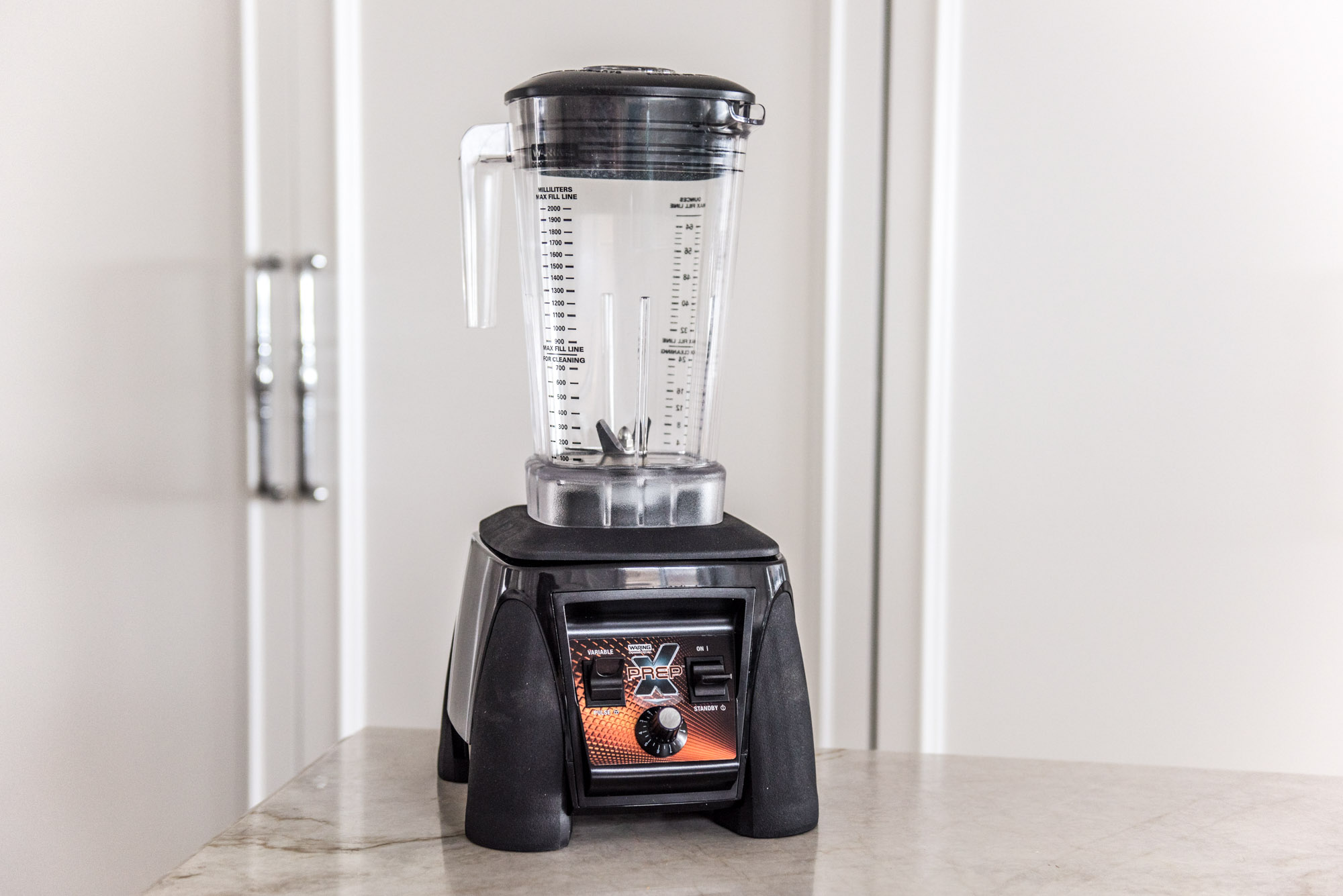
The Waring – MX1200XTX physically resembles the Cleanblend. It has two switches, on/off and pulse/variable, and a dial for adjusting speed. The blender jar has a slight tapering, so the blades’ wingspan reaches a couple of millimeters shy of the jar’s interior.
The variable switch is the default position (held down it engages the pulse function), and we found it took a bit of practice to adjust the dial to the right speed level. The lowest speed was a true low, a nice steady blending motion. The higher speeds (7 to 10) were actually too high, and the vortex spewed ingredients to the top of the jar.
The Waring gave us decent results, however. There was a bit of unground seed in the fruit smoothie, but the green smoothie had the same silky consistency of the Vitamix. The Waring doesn’t have a soup function, and we needed to blend the soup a little longer to get it from a gazpacho to a pureed consistency.
The close positioning of the blades, however, produced a luscious and thick Hollandaise, one of the best of our testing. We had the usual problem with the peanut butter — the peanuts were ground to a paste and lodged beneath the blades. The Waring doesn’t have a separate clean function, but it did the job at the highest speed.
The Waring is certainly a good blender, but the similar and cheaper Cleanblend is better.
6. Breville – BBL620SIL1AUS1
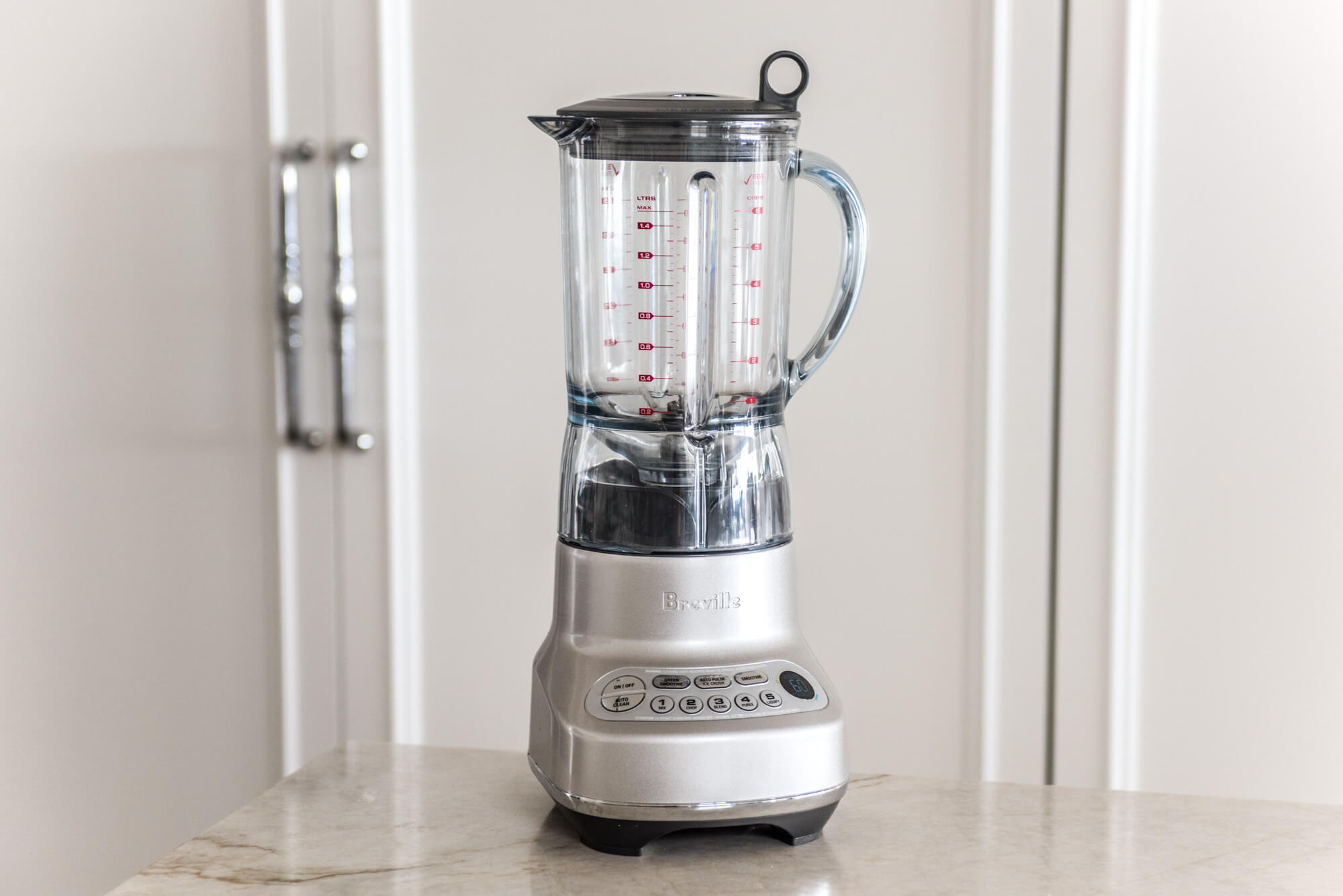
As noted earlier, Breville abruptly discontinued its mid-range blender BBL620XL during our testing period, and based on Breville’s recommendation, we tested its BBL620SIL1AUS1 “Fresh & Furious blender.” We were assured by Breville’s customer service that the Fresh & Furious was a suitable substitute for the BBL620XL and had all the same features.
It short, it didn’t, and the Fresh & Furious did not perform nearly as well. The Fresh & Furious has 1300 watts, which wasn’t quite enough power to pulverize the raspberry seeds and kale. It does have two separate settings for fruit and green smoothies, and although both smoothies were well blended, they were filled with seed bits and sludgy green sediment. A second blending did not improve their consistency.
The Fresh & Furious blender jar isn’t tapered at the bottom, and so we had the usual problems with a non-tapered jar. There is a one-half-inch gap between the jar and the blades, so ingredients got stuck underneath the blades and along the sides and bottom of the jar. The Fresh & Furious has an auto-clean function, but it couldn’t reach the food particles trapped along the two ridges that run the length of the blender jar.
The Fresh & Furious has five speeds with minimal differentiation between the lowest and highest. The low speed didn’t create much of a vortex when blending the eggs for the Hollandaise, so we increased the speed to medium, and we got a decent sauce.
The Fresh & Furious achieved a smooth, creamy peanut butter after eight minutes on the highest speed. As a precaution to prevent motor burn-out, the high speed automatically shuts off after two minutes, a feature we found annoying.
The Breville – BBL620AIL1AUS1 is certainly well made, and it’s a good all-around moderately priced blender. But if you’re looking for a low-end blender for making smoothies on a daily basis, we recommend the slightly less expensive Cleanblend instead.
7. Blendtec – D725C321A1A
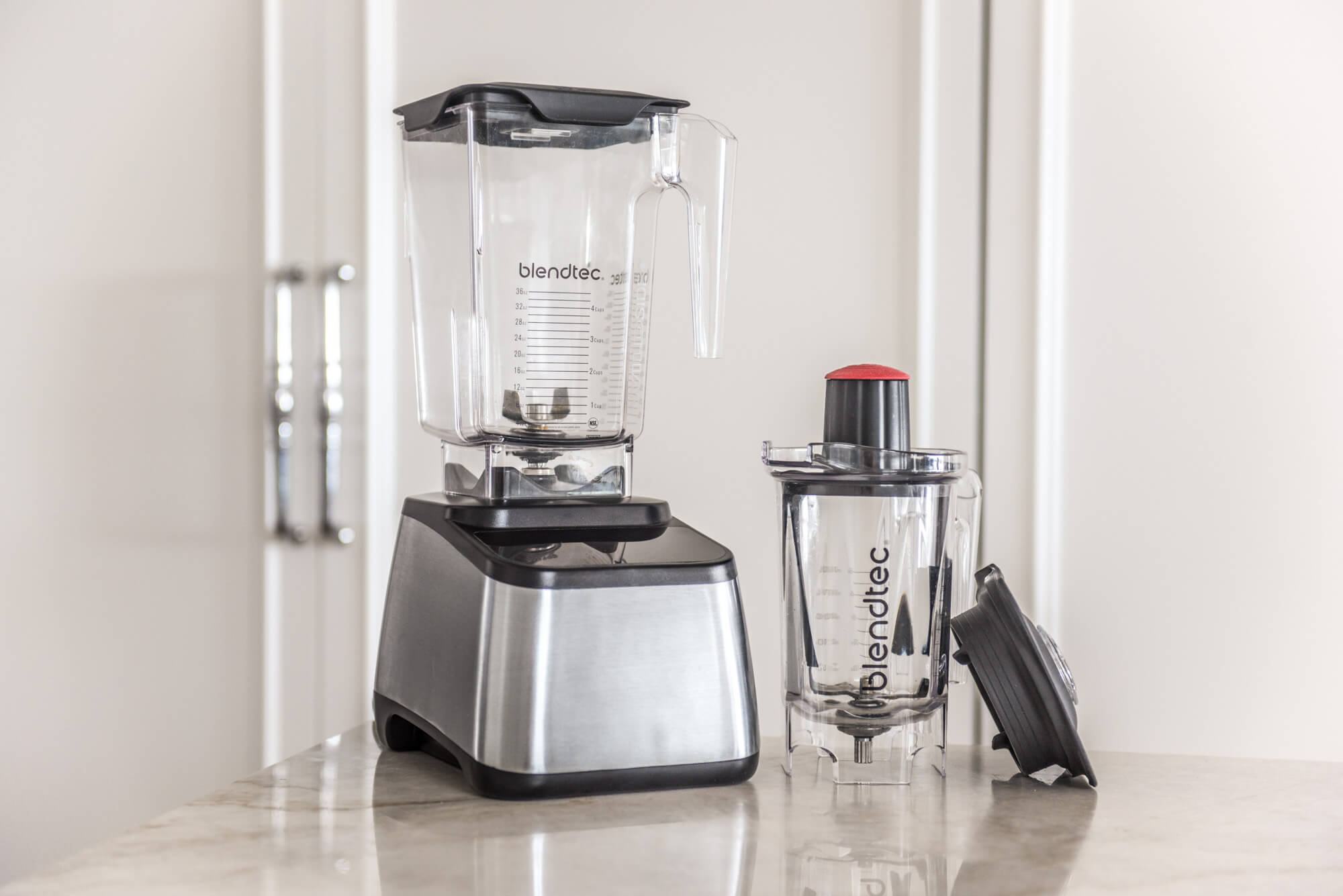
For such an expensive high-performance blender, we were surprised at how poorly Vitamix’s main competitor fared. The Blendtec – D725C321A1A’s control panel is entirely LCD touch screen, including speed control, which needs to be swiped left or right. Each function has a cute little icon, and every time you blend something, a message — such as “Ta-Da!” or “You should tweet this blend” — flashes. Without doubt, we were charmed by these amusing techno touches, but it proved to be a case of style over substance.
Two design flaws impacted the Blendtec’s performance: its blade and its pre-programmed functions. The blade is flat with two prongs each with two “arms” about one-half-inch tall. The jar has almost no tapering, so there is a half-inch gap between the blade arms and the inside of the jar. There is a one-inch gap between the arms and the corners of the jar.
Consequently, the blade could not reach and process the raspberry seeds, nor could it pulverize the apple skin and core. In both tests, the smoothies were grainy and not pleasant to drink. We had the same problem with the peanut butter and Hollandaise. The blade chopped and spun the nuts into a paste that got stuck beneath the blade, and the egg and butter splattered and never emulsified.
In all cases, the timing of the pre-programmed functions was too short, the briefest being the soup function at three minutes, which gave us a decently blended but lukewarm soup. Of course, it could be argued that you can achieve the same results as Vitamix if you used the manual function. We tried, and it didn’t. But since the Blendtec is as expensive as Vitamix, its pre-programmed functions should work the same.
This particular model of Blendtec comes with a mini jar for single servings, which worked better since the jar is about a third of the width and kept the ingredients closely contained.
Like Vitamix, there are a number of Blendtec models, and they might perform as well as Vitamix. But the model we tested, the Designer 725, did not live up to the Blendtec reputation.
8. Ninja – BL660
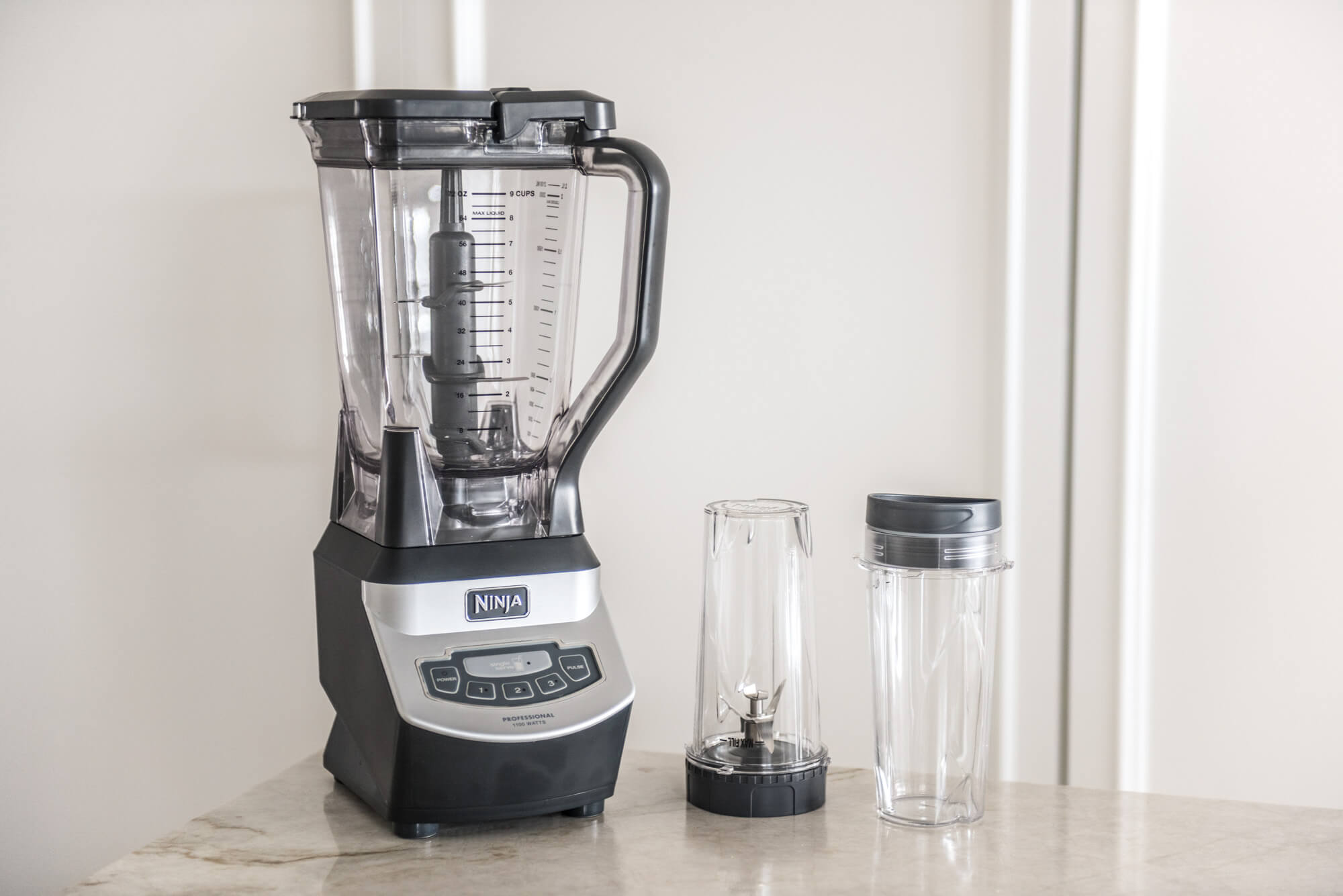
The Ninja – BL660 has three blades affixed to a spindle that fits into the bottom of the jar. After many complaints of injuries from the previous model, Ninja redesigned the spindle so it could be removed for easier and safer cleaning. (We will note that despite our efforts to stay clear of these razor blades, we got nicked twice.)
The largest blade is set in the center of the spindle with the two smaller blades positioned below. Presumably, this design allows the blender to crush ice at the top and distribute it to the lower blades for finer processing. The Ninja did crush the ice to a powdery texture and the smoothies had a slushy consistency.
With both smoothies, the fruit and vegetables were crushed at the blender’s initial burst, but they were not pulverized enough. Each had sediment and a crunchy feel on the tongue. The soup ingredients were well-blended, but again, there was substantial substance to the soup, like a finely chopped salsa. It was pleasantly palatable but not smooth. Blitzing the smoothies and soup additional time did not further process them.
The tiny blade at the bottom of the spindle could barely whip the egg for the Hollandaise, and it couldn’t distribute the ground peanuts upward to the wider blade, neither of which emulsified.
Two single-serving blending cups are included, one with a traditional, removable four-pronged blade. A single-serving function is separate from the three speed levels. It’s basically a pulse function that needs to be pressed until the ingredients are processed. The resulting smoothie had a better consistency and was easier to use than the main blender.
9. KitchenAid – KSB1575CU
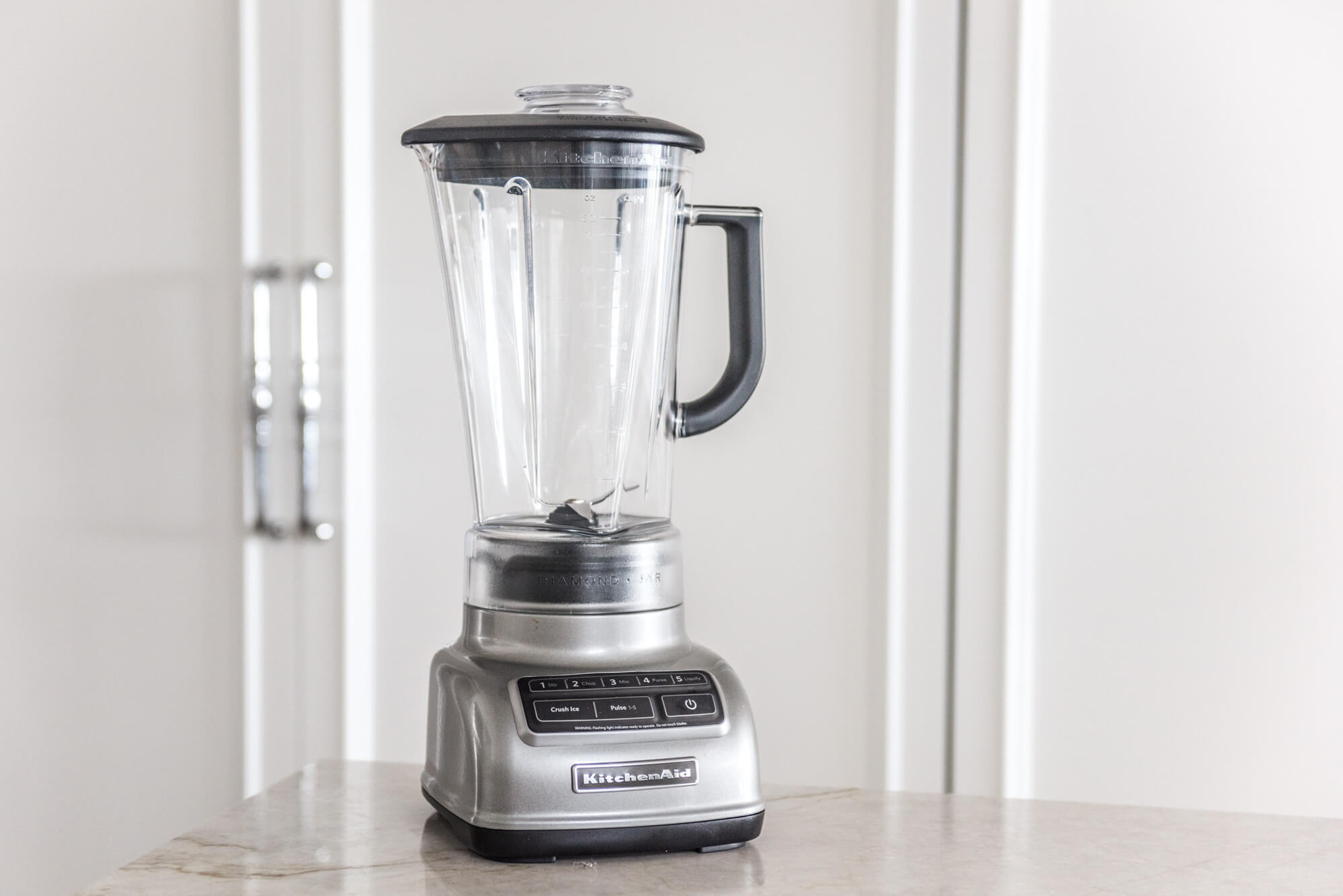
The KitchenAid – KSB1575CU Diamond Blender had the lowest wattage of any blender we tested. At only 550 watts, the Diamond Blender’s motor clearly struggled in all of our tests. Not only did it take longer to blend ingredients, but it also didn’t have enough power to pulverize them to the smooth consistency we achieved with the Cleanblend. Raspberry seeds were left whole, and the green smoothie had a sludgy sediment.
The KitchenAid has five speeds, but we found that the lowest wasn’t a true low and splattered the egg and butter to the top of the blender jar and out the pour spout. The highest speed finely chopped the peanuts, but it didn’t have enough speed to convert them to butter.
The power switch is a big problem because there’s no indication that it’s on or off. Several times during our testing, we thought the power was off, but when we picked up the blender jar, the blades spun and we barely avoided injury.
The KitchenAid we tested is the company’s recent upgrade of its KSB1570 blender, but it did not perform better than Cleanblend or the Ninja.
How we selected products to test
The initial phase of our research comprised of reading through posts on Reddit and Amazon to determine the primary reasons consumers are purchasing a blender and how much they’re willing to spend. We found that an overwhelming majority of people are looking for an inexpensive blender that can make fruit and vegetable smoothies or pre-/post-workout protein shakes with the best-tasting protein powder or protein powder for women.
However, the cheaper blenders for $50 or under don’t have the powerful motors that are needed to break down ice, fruit seeds and skins and sturdy vegetables into a palatable consistency. Another frequent complaint from consumers is that cheaper models simply don’t last long, especially if they’re used on a daily basis.
Vitamix’s marketing and “road show” promotions at warehouse stores have certainly worked in convincing people that a Vitamix will change their lives by significantly improving their diet. However, not everyone wants to spend $600 or more on a blender. So we looked at the wide swath of blenders on the market and divided them into high-end, mid-range, and low-end price categories and see how consumers compared them.
We then cross-referenced the blenders rated the best by consumers with the most recent reviews for blenders at Wirecutter, America’s Test Kitchen and Consumer Reports before deciding on the eight blenders we would test. Finally, since manufacturers are frequently upgrading — or sometimes just changing the appearance of — their blenders, we went to their websites to ensure we would be testing the latest model.
The build quality of a blender corresponds with its price. The more expensive, high-end blenders, are designed and built to last for years. On the opposite end of the scale, budget blenders ($50 and under) aren’t made well enough for long-term use, and their motors tend to burn out after a year or two. However, we did review personal blenders, and one of the best is under $30.
Low end ($100-$199): Occasional use for blending frozen drinks and desserts. The blenders we tested in this category are the Cleanblend, Ninja, Breville, and KitchenAid.
Mid-range ($200-$399): Frequent use for blending smoothies, juices, nut butter, soups, and sauces. These blenders are more advanced than the occasional-use blender and can handle a wider range of food and drink processing tasks. In this category are the Cuisinart and Waring.
High-end ($400-$599): Everyday, heavy-duty blending for diet, weight loss, and overall health improvement. This type of blender would be excellent for raw-food, vegetarian, and vegan diets. There are really only two high-end blenders, the fiercely competitive Vitamix and Blendtec, and they both have several expensive models.
How we tested
We carefully chose several tests that would equitably rate all three categories of blenders. All the blenders advertise that they are the best blender for smoothies, so clearly,y we needed to test that claim.
Ice crushing

Our first test was a simple one: we added two cups of ice cubes to each blender and timed how long it took to pulverize the ice into a snowy consistency, which is necessary for a properly blended smoothie. Half of the blenders had a separate “crush ice” function. For the blenders that didn’t, we simply turned the blender up to its highest speed. All of the blenders pulverized ice to a powdery snow from three seconds (the Ninja) to one minute (Cleanblend).
Fruit smoothies
Most fruit smoothies contain several ingredients: a liquid (such as milk, almond milk, coconut milk), yogurt (usually Greek yogurt, but any style of unsweetened yogurt will do), fresh or frozen fruit and ice. The ingredients should be layered exactly from bottom to top as we’ve listed, since it allows the blender blades to grind the fruit first, then draw the ice down into the vortex to be pulverized and blended with the fruit mixture.
One of the most commonly used fruits is berries — strawberries, raspberries and blueberries. Strawberries and raspberries present a challenge for any blender because of their tiny seeds, which need to be completely ground up and integrated into the smoothie. We decided on this recipe for a raspberry smoothie; it’s simple but would also determine which blender is best for a seeded-fruit smoothie.
Green smoothies
The next most frequently blended smoothie is a green vegetable smoothie. These concoctions also have milk of some sort in their ingredients and a combination of a green vegetable, such as kale or spinach, another vegetable or two, and for sweetness, a bit of fruit. Kale is the heartiest of green vegetables, and it also can be a struggle for a blender to completely grind and pulverize the kale into a smooth green smoothie without any sediment.
This recipe for a kale-apple smoothie tested how well each blender made green smoothies. We thought the apple added enough sweetness and so we omitted the agave. We also left out the flax seeds, since we wanted to focus on how well a blender did in grinding up notoriously tough kale.
As a general note for smoothies, make sure that you use only well-washed organic fruits and vegetables. The blenders blend the whole fruit and vegetable, including seeds and skins. You’ll be drinking them, and you don’t want to ingest pesticides or preservatives.
An egg-based sauce, such as mayonnaise, takes about 30 seconds to make in a blender, and if you haven’t tried it, you’ll be amazed at how easy it is and how much better it tastes than the bottled stuff.
One of our favorite sauces is Hollandaise, and made in the traditional way — whisking eggs over a pot of simmering water — but it’s a bit of a pain. In a blender, however, it’s simple. Basically, it’s mayonnaise with egg yolks, lemon juice and hot butter instead of oil. There’s no cooking involved — other than melting butter in the microwave — and you pour the hot butter into the egg yolks spinning in the blender. Within seconds, the mixture emulsifies, and you have a thick sauce for vegetables or Eggs Benedict.
The Hollandaise test was quite eye-opening because it highlighted the importance of the jar shape and blade position in each blender. The blender jars that were uniform in shape with no tapering failed the test miserably because their blades couldn’t reach the egg yolks in the bottom of the jar. When the speed of the blender was increased, the vortex lifted the eggs up, but they weren’t contained tightly enough to bond chemically with the hot butter. The result was a thin buttery liquid that didn’t hold together as a sauce.
The one test that all of the blenders did well in was a simple tomato-basil soup. We used the Vitamix recipe, because there weren’t many ingredients, and we wanted a soup that required no pre-cooking and took minutes to make. (If you want to make this recipe, only add one-half cup of water and not the two cups as instructed.) Although half of the blenders did not have the “hot soup” function, they all made a relatively smooth and fresh-tasting soup that could be heated up in a microwave.
The most daunting challenge for the blenders was peanut butter since this really put their motors to the test. But also, again, the shape of the blender jar and blade position significantly contributed to the blender’s passing or failing this test.

Only two of the eight blenders we tested — the Cuisinart and the Breville — succeeded at our first attempt. The Vitamix model that we tested had a wide, non-tapered blender jar, so the peanuts were too far spread out in the bottom of the jar for the blades to reach. The peanuts were finely chopped and got lodged beneath the blades. We consulted the instruction manual, and for this particular model, we needed to double the peanuts from two cups to four cups. We tried again, and the second time, the blades could reach the additional peanuts and process them into peanut butter.
Half of the blenders we tested had a self-clean function. This is a pre-programmed button that spins water and dish soap for up to one minute. The function begins at a low speed for a few seconds, then shifts into high speed for about 30 seconds, before finishing at a low speed for the final few seconds.
We did find the self-clean function effectively removed food residue from the top and sides of the jar to beneath the blades.
Important features to consider

Power of motor: Most manufacturers market their blenders’ ability to reach between 2 to 3.5 “peak horsepower.” This is a meaningless claim, as a blender will only reach its peak or maximum speed for a couple of seconds at the pulse function. You will also see a blender’s high RPM advertised (30,000 and upwards), which is also misleading since all blenders work at a high RPM. What’s important is whether the motor can sustain a high RPM without burning out.
A more accurate gauge is the blender’s wattage since you want the blender’s motor to have enough power to handle tough blending and grinding jobs. Think whole, hearty fruits and vegetables or nuts. The blenders we tested fell between 1100 and 1800 watts.
As stated by April Jones in Cooking For Engineers, “Compare watts, not horsepower ratings. Higher watts mean smoother smoothies and a longer motor life.”
Blender jar size and shape: The majority of the blender jars we tested were 64 ounces, which is ample room for the blades to create a vortex that pulls food down into the blades and then pushes it back up for even distribution and blending. We found that jars were those with a slight tapering down to the blades. The tapering created a tighter and more efficient vortex for drawing up ingredients that settled to the bottom.
Blade position: Seven of the eight blenders we tested had wing-shaped blades positioned in the bottom of the jar. The Ninja has a blade spindle with three sets of (wickedly) sharp blades evenly distributed. During our testing, the Ninja’s blade created a centrifuge that whirled ingredients but didn’t entirely pulverize them, and the spindle couldn’t reach ingredients in the lower part of the jar.
The other blenders had two to eight wing-shaped blades. The blades that were the most efficient in our tests had upward and downward prongs and the smallest gap between the tip of the blades and the jar. This position allowed the blades to grab ingredients from the bottom and sides without our needing to constantly scrape the insides of the jar.
Pre-programmed functions: The blenders that we found to be most convenient and easy to use had pre-programmed functions. These functions are at a set speed that the manufacturer considers ideal for blending smoothies, juices, soups, ice-crushing and self- or auto-clean. They can each be adjusted with a variable speed-control dial or button to increase or decrease speed as needed. Two of the low-end blenders, the Ninja and the KitchenAid, do not have adjustable speed control, and it was definitely a function we missed.
Both Vitamix and Blendtec have a single, all-purpose speed/time function for smoothies, but the Breville and Cuisinart have two different speeds and times for fruit and green smoothies. All four blenders made great smoothies, but the blenders that had separate functions dedicated to either fruit or green were slightly better.

Hot-soup function: It’s not a “must have” function, but it’s certainly nice to have. Half of the blenders we tested had a pre-programmed function for blending and then heating the soup to piping hot. (The three low-end blenders and the mid-range Waring do not have the soup function.) The Vitamix and Cuisinart performed exceptionally well, evenly blending and heating the soup in about six minutes. Blendtec’s soup function is programmed at three minutes, and the soup only heated to warm.
Noise: Many consumers apparently have the hearing of bats, because complaints about the noise level of high-performance blenders are voluminous. To be fair, all of the blenders we tested were loud, ranging in sound from a high-pitched whine to the roar of a lawnmower. The quietest blender was the KitchenAid, which also has the lowest wattage (550), so there does seem to be a correlation between the blender’s power and its noise output.
Warranty: If you’re spending a lot of money on a blender, then you’ll want assurance that it’s going to last, and if something fails, the manufacturer’s warranty will repair or replace the blender. The next most frequent consumer complaint is motor burn-out of the low-end blenders, usually after about a year, and the manufacturer’s limited one-year warranty no longer covers replacement or repair.
The Cleanblend — our top pick in the low-end category — is the exception and has a remarkable five-year full warranty. Vitamix and Blendtec are confident that their blenders are solidly built and have the most impressive warranties, 10-year and eight-year, respectively.
The bottom line
The type of blender you might consider purchasing is linked to your lifestyle and diet. The eight blenders that we tested ran the gamut from occasional blending (a couple of times a month) to frequent blending (twice or more a week) to daily use.
Many people think spending $50 for a blender is too much, and if they’re just using it for whipping up frozen margaritas on Cinco de Mayo, they’re probably right. In most cases the old adage “you get what you pay for” applies to blenders. A powerful motor — 1500 watts — doesn’t come cheap, but our testing showed that it takes more than a strong motor to make a good blender. The shape of the blender jar and the blade position in the jar are equally important.
We chose the Cuisinart – CBT-2000 as the best overall, mid-range blender for making smoothies on a frequent basis. Its five programmed functions and precise manual control make this blender exceptionally easy to use.
At a whopping $600, our high-end pick, the Vitamix – A3500, pulverizes virtually anything edible into silky smoothies and creamy soups in minutes. Even if you used it several times a day, the Vitamix – A3500 is built to last for years, and its 10-year warranty is the best you’ll find anywhere.
Our low-end choice, the Cleanblend – 2001, doesn’t have programmed functions and is manually controlled, but its powerful 1800-watt motor liquefies fruits, vegetables, and seeds nearly as well as Vitamix. It’s a great, affordable blender for frequent or everyday use.
More Reviews
The Best-Tasting Protein Powders
Optimum Nutrition
The Best Book Subscription Boxes
Once Upon a Book Club
RTIC - 30-Ounce Tumbler
Thermos - Sipp
Klean Kanteen - 20-Ounce Insulated
Black+Decker - Purifry
HelloFresh Meal Delivery Kit Review
HelloFresh
Lucky Jerky


